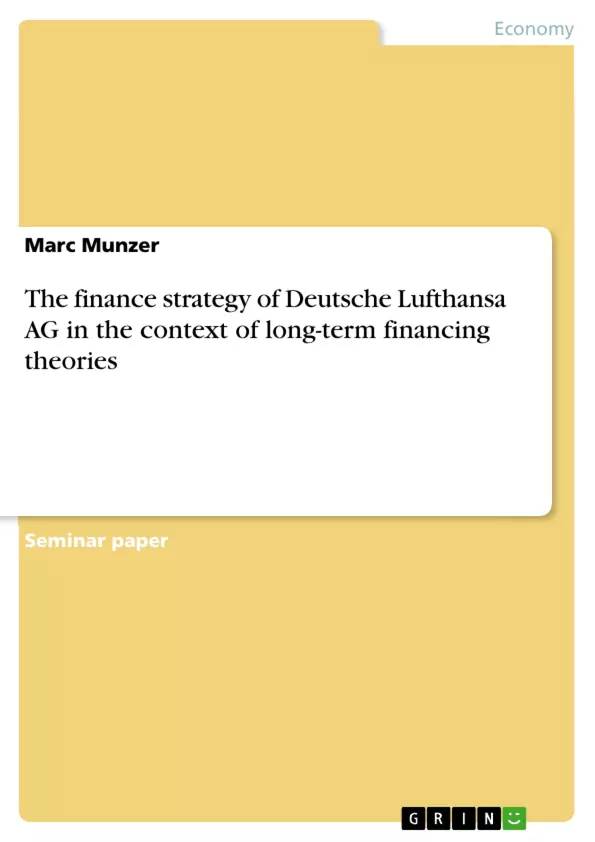Long-term financing and therefore the question of capital structure is essential for all kinds of business. Every organisation should take into account financing patterns in order to set up a target capital structure, which reduces the cost of capital. The optimal capital structure tends to rely on a variety of factors, such as industry, ownership structure, personal attitude to risk, nationality, and dimension of asymmetric information. Due to the significance, many theories regarding these matters have been developed with sometimes more contradictory explanations.
This paper deals with the long-term financing patterns of the Deutsche Lufthansa AG. Firstly, the work gives a brief company’s profile and investigates its capital structure. Further, the composition of shareholders’ equity and debts are examined in order to critically asses Lufthansa’s rationale for its financing mix. Finally, referred on relevant long-term financing theories, the work summarizes the findings.
[...]
Inhaltsverzeichnis (Table of Contents)
- List of Abbreviations
- List of Figures and Tables
- Introduction
- Brief company profile
- Finance strategy
- Capital Structure
- Capital Structure Theories
- Conclusion
- Appendix
- References
Zielsetzung und Themenschwerpunkte (Objectives and Key Themes)
This paper explores the long-term financing patterns of Deutsche Lufthansa AG. The primary objective is to analyze the company's capital structure and critically assess the rationale behind its financing mix. The paper aims to achieve this by examining the composition of shareholders' equity and debt, referencing relevant long-term financing theories, and drawing conclusions based on these findings.
- Long-term financing patterns of Deutsche Lufthansa AG
- Capital structure analysis
- Rationale behind Lufthansa's financing mix
- Application of long-term financing theories
- Critical assessment of Lufthansa's financing strategy
Zusammenfassung der Kapitel (Chapter Summaries)
The introduction establishes the importance of long-term financing and capital structure for businesses, highlighting the diverse factors influencing the optimal capital structure. It also introduces the paper's focus on Deutsche Lufthansa AG.
The "Brief company profile" section provides a concise overview of Deutsche Lufthansa AG, outlining its structure, operations, and key aspects of its business model. This section lays the groundwork for understanding the company's financing decisions.
The "Finance strategy" section delves into Lufthansa's approach to financing, analyzing its capital structure and the factors influencing its financing mix. This section explores the company's use of debt, equity, and other financial instruments to fund its operations.
The "Capital Structure" section examines the specific composition of Lufthansa's capital structure, analyzing the relationship between debt and equity. This section provides detailed information about the company's financial leverage and the impact of its capital structure on its financial performance.
The "Capital Structure Theories" section explores relevant theories of capital structure, linking theoretical frameworks to Lufthansa's observed financing patterns. This section critically assesses the applicability of these theories to Lufthansa's specific situation.
Schlüsselwörter (Keywords)
The paper focuses on the long-term financing patterns of Deutsche Lufthansa AG, examining its capital structure, financing mix, and the application of relevant long-term financing theories. Key terms and concepts include capital structure, debt financing, equity financing, cost of capital, weighted average cost of capital (WACC), Modigliani and Miller (MM) theory, trade-off theory, pecking order theory, and financial leverage.
- Arbeit zitieren
- Marc Munzer (Autor:in), 2009, The finance strategy of Deutsche Lufthansa AG in the context of long-term financing theories, München, GRIN Verlag, https://www.grin.com/document/133548



